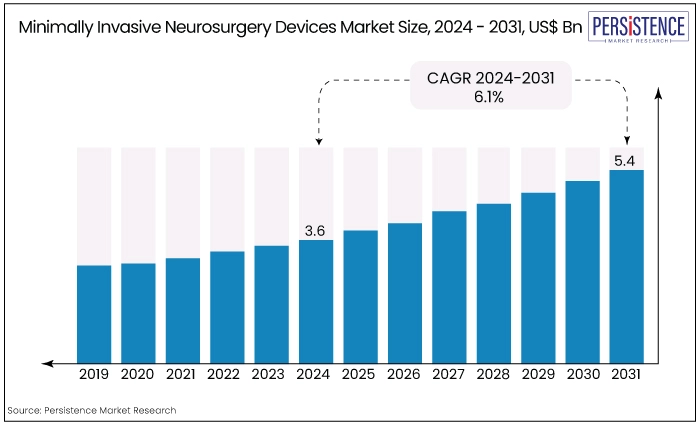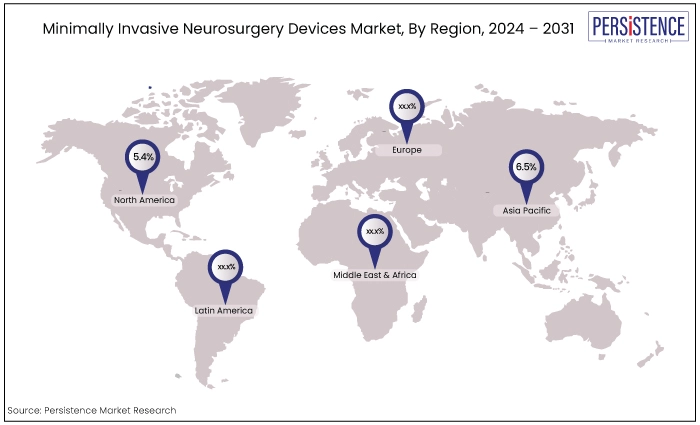Industry: Healthcare
Format: PPT*, PDF, EXCEL
Delivery Timelines: Contact Sales
Report Type: Ongoing
Report ID: PMRREP34657
The global market for minimally invasive neurosurgery devices is estimated to value at US$5.4 Bn by the end of 2031 from US$3.6 Bn recorded in 2024. The market is expected to secure a CAGR of 6.1% in the forthcoming years from 2024 to 2031.
Key Highlights of the Market
|
Market Attributes |
Key Insights |
|
Market Size (2024E) |
US$3.6 Bn |
|
Projected Market Value (2031F) |
US$5.4 Bn |
|
Forecast Growth Rate (CAGR 2024 to 2031) |
6.1% |
|
Historical Growth Rate (CAGR 2018 to 2023) |
5.7% |
The market for minimally invasive neurosurgery devices has witnessed substantial growth driven by technological advancements, increasing prevalence of neurological disorders, and rising demand for less invasive surgical procedures.
These devices play a crucial role in enhancing surgical precision, reducing recovery times, and minimizing post-operative complications compared to traditional open surgeries.
Key factors driving market growth include the integration of robotics and neuro-navigation systems, which enable surgeons to perform complex procedures with greater accuracy.
Additionally, the development of multi-functional devices that combine diagnostic and therapeutic capabilities has expanded the treatment options available to neurosurgeons.
There is also a notable market trend towards miniaturization of devices, allowing for less invasive interventions and improved patient outcomes.
Geographically, North America holds a significant share in the market, driven by robust healthcare infrastructure, high adoption rates of advanced medical technologies, and supportive reimbursement policies.
However, Asia Pacific is expected to exhibit notable growth due to increasing healthcare expenditure, rising awareness about minimally invasive techniques, and expanding access to healthcare facilities in emerging economies.

The market for minimally invasive neurosurgery devices has experienced significant historical growth, propelled by advancements in technology and increasing demand for less invasive surgical options.
Over the years, innovations such as robotic systems, neuro-navigation tools, and improved imaging techniques have revolutionized neurosurgical procedures, enhanced precision and patient outcomes while reducing recovery times and complications.
Looking ahead, the market is poised for continued expansion driven by several factors. These include the rising prevalence of neurological disorders globally, particularly as populations age, leading to greater demand for effective treatment options.
Moreover, ongoing research and development efforts are expected to bring forth new generations of devices with enhanced capabilities, further driving adoption.
Geographically, regions like North America, and Europe have been at the forefront due to advanced healthcare infrastructure and high adoption rates of innovative medical technologies.
However, emerging economies in Asia Pacific, and Latin America are increasingly becoming key growth markets, supported by improving healthcare infrastructure, rising healthcare expenditure, and growing awareness among both patients and healthcare providers.
Cutting-Edge Tech Transforms Neurosurgery
The ongoing development and enhancement of neuroendoscopic devices, robotic systems like ROSA ONE Brain, and neuro-navigation tools have significantly revolutionized neurosurgical procedures.
These advanced technologies have markedly improved the precision, safety, and effectiveness of surgeries, allowing for more accurate targeting and minimal invasiveness.
For instance, the ROSA ONE Brain system enables surgeons to perform complex operations through tiny holes in the skull instead of large craniotomies, reducing recovery times and postoperative complications.
Similarly, neuro-navigation tools offer real-time imaging and guidance, enhancing the surgeon’s ability to navigate intricate brain structures with greater accuracy. These technological advancements are transforming neurosurgery, making procedures less traumatic and improving patient outcomes.
Rising Neurological Disorders
With nearly one in six people worldwide suffering from neurological disorders, the demand for advanced neurosurgical solutions has surged.
Conditions such as Alzheimer’s, Parkinson’s, strokes, epilepsy, and brain injuries affect up to 1 billion people, leading to significant morbidity and mortality annually.
The economic burden is equally substantial, with Europe alone facing costs of approximately €139 billion in 2004. As the global population ages, particularly in countries with an increasing percentage of people over 65, the prevalence of these disorders is expected to rise.
This escalating incidence highlights an urgent need for advanced, effective treatments. Minimally invasive neurosurgery devices, such as the NICO BrainPath and neuro-navigation systems, offer precise, safer alternatives to traditional open surgeries.
These innovations reduce recovery times and complications, providing significant benefits over conventional methods.
Despite the availability of effective treatments, many regions, particularly in developing countries, lack adequate healthcare infrastructure and trained personnel to deliver these interventions.
By integrating neurological care into primary health care and employing low-technology interventions, access to appropriate care can be improved. Consequently, the increasing prevalence of neurological disorders is a major driver for the growth and innovation in the minimally invasive neurosurgery devices market.
High Costs Curtail Access
The high costs associated with these devices and procedures pose a significant barrier to market growth. Advanced devices like neuro-navigation systems, neuroendoscopic equipment, and specialized instruments such as the NICO BrainPath, while offering significant clinical benefits, come with hefty price tags.
These devices often require substantial investment not only for purchase but also for maintenance, training, and operation. The expenses are further compounded by the costs of the procedures themselves, which can be prohibitive for many healthcare providers, especially in developing regions.
The financial burden extends to patients, who may face high out-of-pocket expenses due to inadequate insurance coverage for these advanced treatments.
This economic barrier limits the accessibility of cutting-edge neurosurgical care, particularly in low- and middle-income countries where healthcare budgets are already constrained. Consequently, despite the potential for improved patient outcomes and reduced recovery times, the adoption remains restricted.
Multi-Functional Products Expanding Horizons in Minimally Invasive Neurosurgery Devices
The development of multi-functional products represents a pivotal opportunity in the minimally invasive neurosurgery devices market. These innovations integrate diverse functionalities into single devices, offering enhanced versatility and efficiency during surgical procedures.
For instance, advanced neuro-navigation systems now incorporate imaging capabilities with real-time guidance, enabling precise navigation through complex brain structures.
Similarly, robotic systems like the da Vinci Surgical System have evolved to perform intricate neurosurgical tasks with high precision and minimal invasiveness.
These multi-functional devices not only streamline procedures but also contribute to improved patient outcomes by reducing surgical complications and recovery times.
Moreover, they optimize healthcare resource utilization by minimizing the need for multiple devices and procedures, thereby lowering overall healthcare costs. The market is witnessing a surge in such innovations, driven by technological advancements in robotics, imaging modalities, and material sciences.
Increasing Penetration Amidst Prevalent Social Stigma
Overcoming cultural and social stigma presents a significant opportunity in the minimally invasive neurosurgery devices market. Historically, neurological disorders have been surrounded by misconceptions and stigmas in many cultures, affecting patient willingness to seek treatment and hindering the adoption of advanced surgical techniques.
However, with increasing awareness and education, coupled with advocacy efforts by healthcare professionals and patient support groups, perceptions are gradually shifting.
In regions where traditional beliefs and fear of invasive procedures prevail, educating communities about the benefits of minimally invasive neurosurgery devices has become crucial.
The procedures offer reduced recovery times, minimal scarring, and lower risks of complications compared to traditional open surgeries. By highlighting these advantages and debunking myths, healthcare providers can foster trust and encourage more patients to opt for advanced treatments.
Technological advancements in neurosurgical devices, such as robotic-assisted systems and high-definition imaging technologies, further contribute to overcoming stigma. Such innovations enhance precision and safety during procedures, instilling confidence in both patients and healthcare providers.
Companies like Medtronic, and Intuitive Surgical continue to innovate, developing devices that are not only effective but also culturally sensitive and adaptable to diverse patient needs.
|
Category |
Projected CAGR through 2031 |
|
Device Type Category - Robotic Systems |
5.1% |
|
End User - Hospitals |
6.3% |
Robotic Systems Remain Dominant by Device Type
The robotic systems segment is poised to capture a substantial share within the device types of neurosurgeries. These advanced systems, exemplified by innovations like robotic-assisted surgical platforms, enhance surgical precision and offer minimally invasive approaches.
By integrating robotic technologies into neurosurgical procedures, surgeons can achieve greater accuracy, reduced recovery times, and improved patient outcomes.
This segment's growth is driven by increasing adoption in hospitals globally, where the demand for sophisticated surgical techniques that minimize invasiveness and maximize efficacy continues to rise.
As technology evolves, robotic systems are expected to play an increasingly pivotal role in shaping the future landscape of neurosurgery.
Hospitals Show Notable Growth in Adoption
Hospitals are poised for significant growth as key end users in the minimally invasive neurosurgery devices market. These institutions serve as the primary settings for complex neurosurgical procedures, where the demand for advanced technologies like neuro-navigation systems, robotic surgical platforms, and minimally invasive instruments is on the rise.
Hospitals offer specialized infrastructure and skilled medical professionals capable of utilizing these advanced devices to perform intricate surgeries with precision and minimal invasiveness.
As healthcare facilities prioritize patient outcomes and operational efficiency, the adoption of minimally invasive techniques continues to expand, driven by benefits such as reduced recovery times, lower post-operative complications, and improved patient satisfaction.
This market trend underscores hospitals' pivotal role in driving the evolution and widespread adoption of minimally invasive neurosurgery devices, thereby shaping the future of neurological care delivery worldwide.
|
Region |
CAGR through 2034 |
|
North America |
5.4% |
|
Asia Pacific |
6.5% |
North America Marches Ahead with Strong Reimbursement Support
North America is poised to dominate the minimally invasive neurosurgery devices market, primarily due to stringent regulatory oversight by agencies like the FDA. These regulations ensure the safety and efficacy of devices, bolstering confidence among healthcare providers and patients alike.
The region's advanced healthcare infrastructure, coupled with a high prevalence of neurological disorders and an aging population, drives demand for innovative neurosurgical technologies.
Favorable reimbursement policies and ongoing technological advancements further contribute to the region's significant share in promoting minimally invasive procedures for neurosurgery, enhancing patient outcomes and reducing healthcare costs.
Rate of Adoption Accelerates in Asia Pacific
Asia Pacific is expected to exhibit a notable CAGR in the minimally invasive neurosurgery devices market. This growth can be attributed to several factors. Firstly, increasing healthcare expenditure and improving healthcare infrastructure in countries like China, India, and Japan are driving market expansion.
Additionally, the rising prevalence of neurological disorders, coupled with a growing elderly population, is boosting the demand for advanced neurosurgical technologies.
Moreover, favorable government initiatives aimed at enhancing healthcare accessibility and affordability are further propelling market growth in the region.
As awareness about the benefits of minimally invasive procedures increases among healthcare providers and patients, the adoption of these devices is expected to rise, contributing to the overall growth of the Asia Pacific neurosurgery devices market.

Acquisitions and partnerships, along with the development of innovative products and the expansion of production capacities, are key growth strategies followed by major players in the minimally invasive neurosurgery devices market.
June 2024
Endiatx, a pioneering Silicon Valley medical technology company, introduced micro-robotics inside the human body. The company's flagship innovation, PillBot™, is designed to wirelessly navigate the human stomach, lowering costs and increasing access to diagnosis and treatments.
February 2022
CereVasc, Inc., a privately held, clinical-stage, medical device company developing novel, minimally invasive treatments for neurological diseases, announced that the U.S. Food and Drug Administration (FDA) has approved an investigational device exemption (IDE) application to initiate a pilot trial of the eShunt System in patients with normal pressure hydrocephalus (NPH).
|
Attributes |
Details |
|
Forecast Period |
2024 to 2031 |
|
Historical Data Available for |
2018 to 2023 |
|
Market Analysis |
US$ Billion for Value |
|
Key Regions Covered |
|
|
Key Market Segments Covered |
|
|
Key Companies Profiled in the Report |
|
|
Report Coverage |
|
|
Customization & Pricing |
Available upon request |
By Device Type
By Application
By Region
To know more about delivery timeline for this report Contact Sales

Minimally invasive neurosurgery devices are advanced surgical instruments and technologies designed to perform brain and spinal procedures through small incisions, reducing recovery times and complications compared to traditional open surgeries.
The key drivers include technological advancements in robotics and neuro-navigation, rising prevalence of neurological disorders, and increasing demand for less invasive surgical options.
Challenges include the high cost of devices and procedures, regulatory complexities, and the learning curve associated with adopting new technologies.
Future opportunities lie in the development of multi-functional products, expanding healthcare infrastructure in emerging economies, and innovative partnerships to improve patient access and outcomes.
North America is expected to account for the significant share in the market.